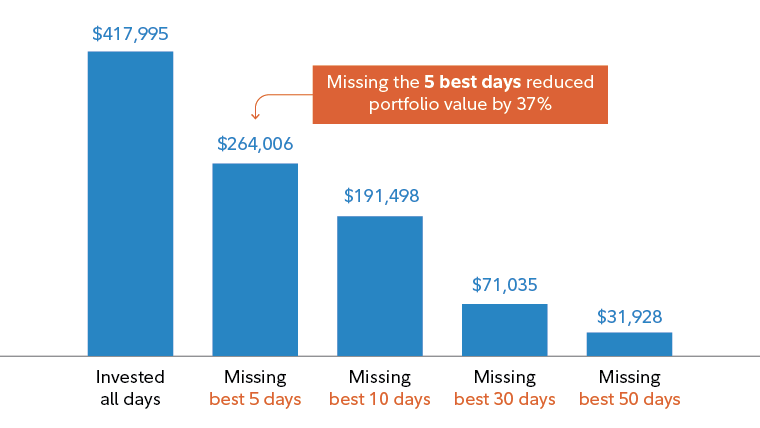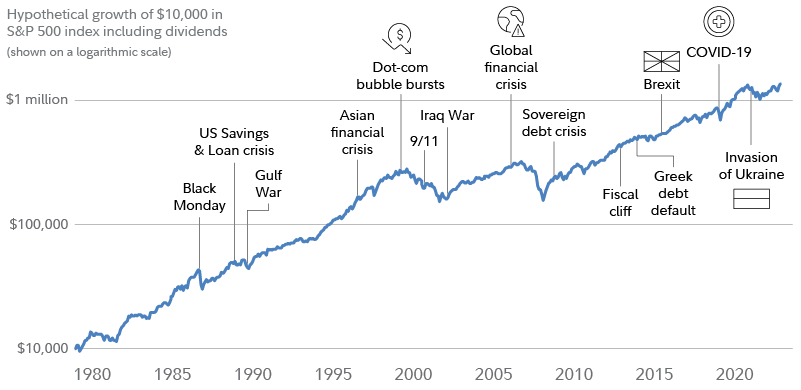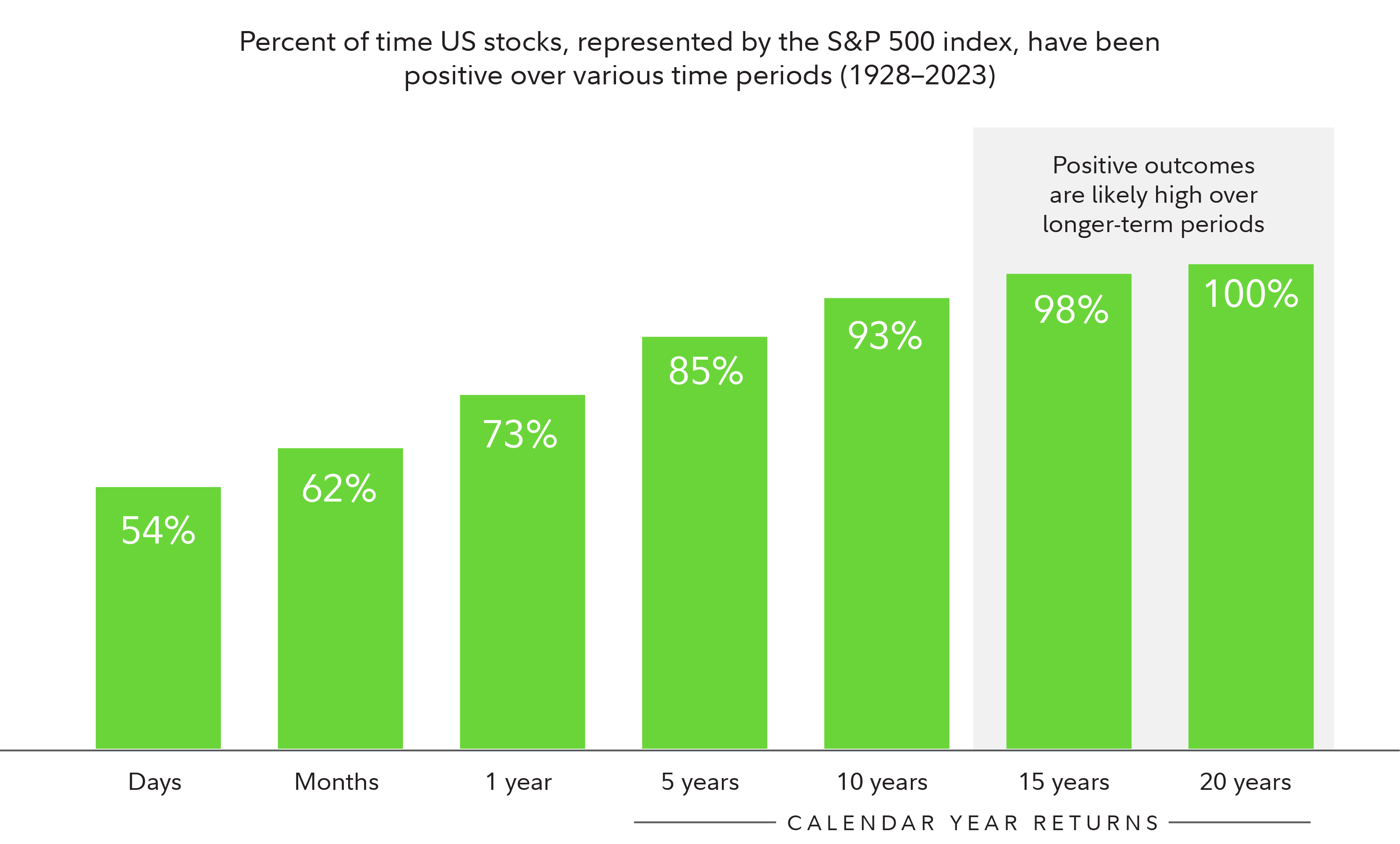6 reasons to consider investing right now
Set emotions aside and take a closer look at the data.
- Keeping investors assets in cash may feel safe, but it's not without risk.
- History shows that there's no "wrong" time to invest; what's important is getting invested and staying invested.
- Uncertainty can be daunting, but historically, the stock market has ultimately persevered in the face of even the most serious challenges.
In times of uncertainty, it can be difficult to willingly expose an investor to risk. But when it comes to investing, an overabundance of caution can be riskier than one may realize.
Holding assets in cash because it may feel safer than investing in stocks or bonds at the moment, or because there is concern about what the near future might hold for the economy, may be putting an investor's prospects for long-term growth in danger.
"Some investors may feel that they're getting a return on their short-term investments which could potentially offer different risk and return profiles compared to the stock or bond market. The extra performance potential that may exist in those markets may not seem worth the extra volatility," says Naveen Malwal, an institutional portfolio manager with Strategic Advisers, LLC.
"But staying out of the market may have its own risks when it comes to achieving financial goals. For example, the S&P 500® is up nearly 40% over the last year,1 even amid all the uncertainty around inflation, interest rates, and the election, on the back of robust corporate earnings growth. That, in a nutshell, captures the risk of staying in cash."
In fact, putting cash to work sooner rather than later may potentially offer benefits for investors. Here are 6 reasons why an investor may not want to wait any longer.
1. History shows that there's no "wrong" time to get in the market
If an investor is holding a large cash allocation because they're worried about investing their money at the wrong time, they may be doing themselves a disservice. We looked at how a hypothetical, annual $5,000 investment would perform in various scenarios. What we found is that even if that money was invested at the "worst" possible time each year—that is, when the market was at its peak—it would still significantly outperform a cash allocation over time.

Past performance is no guarantee of future results. Source: Bloomberg Finance, L.P. from 12/31/1979 to 12 /1/2023. Stocks S&P 500® Index Cash generic US. It is not possible to invest directly in an index. All indexes are unmanaged. Analysis based on growth of an annual hypothetical $5,000 investment in stocks, represented by the S&P 500® during a best timing year (defined as investing $5,000 at a market bottom each year), during a worst timing year (defined as investing $5,000 at a market top each year), at the start of every year $5,000 in January of each year), divided monthly (about $417/month) and in a cash only portfolio.
Since it's difficult, if not impossible, to identify when markets are at their peak or have reached their bottom, most investors would be best served by simply investing their money on a regular basis without regard for timing.
"Historically, market timing has been practically impossible to do consistently. And those who've attempted it often fell behind investors who simply put their money to work on a consistent basis," says Malwal.
As the chart above shows, investing our hypothetical $5,000 at the start of every year or on a monthly basis would still have provided ample growth, and, in the case of the former, only slightly less than if our hypothetical investor had the ability to perfectly predict when the market had reached its bottom.
Our research also shows which stage of the business cycle an investor chooses to put their money in the market may have very little effect on the average, long-term performance of their portfolio.

Real return is the total return of an investment less the rate of inflation. Past performance is no guarantee of future results. For illustrative purposes only. It is not possible to invest directly in an index. All indexes are unmanaged. Sample Portfolio: 36% Domestic Equity 24%, International Equity, 40% Investment-Grade Bonds. Portfolio based on Dow Jones U.S. Total Stock Market Index, MSCI ACWI ex-US Index, Bloomberg US Aggregate Bond Index, as of 12/31/23. This historical analysis is based on Monte Carlo analysis based on historical index returns. "Range of expected returns" illustrates simulations between the 25th and 75th percentile. The simulations represent an 85% confidence interval. Actual returns could potentially be higher or lower.
This means that making investment decisions based on where an investor thinks the US economy is in its business cycle or where it may be headed isn't likely to have a dramatic effect on long-term outcomes. Even investing during a recession has historically provided an average expected return in line with other, less volatile parts of the business cycle.
2. Being out of the market for even a short time can significantly reduce growth
When an investor gets into the market isn't likely to make a big difference in their long-term growth potential—but being out of the market, even for a short period, certainly can. As the chart below shows, a hypothetical investor who missed just the best 5 days in the market since 1988 could have reduced their long-term gains by 37%.
Hypothetical growth of $10,000 invested in the S&P 500 Index, January 1, 1988–December 31, 2023.

Past performance is no guarantee of future results. Source: Fidelity, Bloomberg as of 12/31/23. This is based on the cumulative percentage return of a hypothetical investment made in the noted index during periods of economic expansions and recessions. Index returns include reinvestment of capital gains and dividends, if any, but do not reflect the impact of taxes, fees, or expenses, which would lower these figures. This return information is not intended to imply any future performance of the investment product. "Best days" were determined by ranking the one-day total returns for the S&P 500® Index within this time period and ranking them from highest to lowest. There is volatility in the market and a sale at any point in time could result in a gain or loss. See important information for index definitions. Your own investment experience will differ, including the possibility of losing money. It is not possible to invest directly in an index. All indexes are unmanaged. Source: Bloomberg, S&P 500 Index® total return for 12/31/49 to 12/31/23; recession and expansion dates defined by the National Bureau of Economic Research (NBER). The S&P 500 Index was created in 1957; however, returns have been reported since 1926, and the index has been reconstructed for years prior to 1957.
3. Stocks have tended to rise even amid upheaval and uncertainty
If an investor is concerned about the effect that so-called "black swan" events might have on their portfolio, it may be helpful to consider how markets have reacted to challenging periods in the past. While past performance does not guarantee future returns, historically, markets have persevered through times of strife and uncertainty. Be it war, recession, or even the COVID-19 pandemic, stocks have historically shown resilience during short-term volatility, which could potentially lead to long-term gains for investors.

Sources: Fidelity Investments, Bloomberg Finance, L.P., 1/1/85–12/31/23. Past performance is no guarantee of future returns. This is for illustrative purposes only and not indicative of any investment. Indexes are unmanaged. Stocks are represented by the S&P 500® Index. It is not possible to invest directly in an index. The S&P 500® Index is a market capitalization–weighted index of 500 common stocks chosen for market size, liquidity, and industry group representation. S&P and S&P 500 are registered service marks of Standard & Poor's Financial Services LLC.
Moreover, stocks have the potential to recover from these disruptions. For example, stocks have, on average, historically recovered just 11 months after a recession began, often surpassing their pre-recession highs. Getting or staying out of the market when times seem tough could result in missing out on potential recovery periods.
"Back in 2020, for instance, there was a lot of concern about the global economy and people feared that we might be seeing a repeat of the 2008 financial crisis. Back then, the markets fell considerably and took a long time to recover," says Malwal. "But what we actually saw in 2020 was that the market, despite suffering an extreme pullback through March of that year, went on to rally the rest of the year. By the end of the year, the stock market was up almost 20%, even though we had a global pandemic and a severe recession that year. If you knew that the pandemic was coming and sat in cash thinking it was less risky, you likely would've fallen behind."
4. Investing in the market for a longer period may potentially increase an investor's chances of experiencing positive outcomes
When an investor is looking at short-term stock market performance, whether or not they'll see a good day can seem as random as a coin flip. And that's largely true—since 1928, stocks have tended to have a positive outcome on just over half the days. Zoom out a little, however, and there is a bit of a different story.
"In the short term, the stock market can feel volatile, but the odds of seeing a positive outcome potentially improve the longer you stay invested," says Malwal. "For example, if you're in the market for a year, there's been an almost 3 out of 4 chances that you've seen a positive return in the past. And the further out you go, the odds may change. Now, of course, past performance can't guarantee the future, but it seems like the odds are overwhelmingly in the favor of an investor who stays in the market over one who does not."

Past performance is no guarantee of future results. U.S. stocks are represented by S&P 500 returns. This is for illustrative purposes only and not indicative of any investment. An investment cannot be made directly in an index. All indexes are unmanaged. The S&P 500 Index was created in 1957; however, returns have been reported since 1926, and the index has been reconstructed for years prior to 1957. Source: Bloomberg, as of 12/31/23.
"Another way to think about it is to take the inverse," says Malwal. "A cash investor may only have a 1 in 4 chance of seeing a positive outcome over a single year, or a 2% chance over 15 years. Knowing that, it seems intuitive to be drawn toward the stock market even though there are risks involved."
5. Which party controls Washington has historically tended to have little effect on stock returns
Although popular myths sometimes suggest that one party or the other is "better" for market returns, the historical data does not bear out these theories. The S&P 500 has historically averaged positive returns under nearly every partisan combination, as the chart below shows. "Historically," says Malwal, "there hasn't been a strong relationship between Election Day outcomes and how markets perform from there on out. As a result, the investment team that I'm a part of at Strategic Advisers doesn't adjust our positioning based solely on election outcomes."

Past performance is no guarantee of future results. Source: Retirement Researcher, "Are Republicans or Democrats better for the Stock Market", retrieved 2/19/24. Data from 1926 through 2023. Unified government means that the Presidency, the House of Representatives, and the Senate are all controlled by a single party. Divided government means that at least one house of Congress or the Presidency is controlled by the other party. Stocks are represented by the S&P 500® index. It is not possible to invest directly in an index. All indexes are unmanaged.
Malwal warns against acting in response to promises made during the campaign. "There are dramatic differences between the proposals expressed on the campaign trail and the actual policy changes that take place once the candidate is in office," says Malwal. "It's exceedingly rare that a candidate will be able to deliver on exactly what they've proposed once they take office. If you're making investment decisions based on such proposals, it's important to consider the potential risks involved."
6. Rising deficits and persistent inflation may pose a risk to cash portfolios
The impact of inflation and the ever-rising national debt are 2 concerns that many investors are especially wary of, given recent history. While inflation has been ebbing recently and rising deficits are more of a longer-term issue, the effects of both could leave an investor's cash allocation in a particularly vulnerable position.
"If you are concerned about these things, it's important to understand that all investments, including short-term ones, carry some level of risk," says Malwal. "If inflation stays at current levels or rises over time, or if the deficit continues to rise and leads to higher interest rates, it may make sense to invest in a diversified portfolio. Investing in a diversified portfolio may potentially help your wealth grow, and as it grows, you may have more flexibility to adapt to changes in interest rates or tax rates. If you're sitting in cash and your wealth isn't growing as much, you may find it more challenging to respond to those shifts."
Finding the right balance and sticking to it
Investing can potentially offer opportunities for growth. But that doesn't mean there's no place for cash in an investor's portfolio. What's important is that the investor finds an allocation that suits their particular needs, giving them the growth potential to reach their goals while providing the security necessary to ride out periods of volatility.
"We find that investors are typically more comfortable having a mix of stocks, bonds, and short-term investments in their portfolio," says Malwal. "And how that mix is determined comes down to a number of factors, including their time horizon, their risk tolerance, and what goal they're trying to achieve. Whether you're managing your portfolio on your own or working with a professional who can give you appropriate guidance, it can be helpful to think about your portfolio in terms of these factors rather than getting caught up in the concerns and fears you may be seeing in the news."
Next steps to consider

Fixed Income: Investment Grade
Get help giving your clients a more competitive edge with our full spectrum of fixed income investments.
Learn more

Model Portfolios
See how model portfolios can help you support your clients' many investment objectives, while also freeing up time for more meaningful conversations.
Learn more

Money Market Funds
Discover how our money market funds seek to provide stability, liquidity, and competitive returns for our customers.
Learn more
1. Source: “S&P 500 1 Year Return,” Ycharts. As of 10/31/2024.
Keep in mind that investing involves risk. The value of your investment will fluctuate over time, and you may gain or lose money.
Past performance is no guarantee of future results.
All indexes are unmanaged, and performance of the indexes includes reinvestment of dividends and interest income, unless otherwise noted. Indexes are not illustrative of any particular investment, and it is not possible to invest directly in an index.
Diversification and asset allocation do not ensure a profit or guarantee against loss.
Views expressed are as of the date indicated, based on the information available at that time, and may change based on market or other conditions. Unless otherwise noted, the opinions provided are those of the speaker or author and not necessarily those of Fidelity Investments or its affiliates. Fidelity does not assume any duty to update any of the information.
Stock markets are volatile and can fluctuate significantly in response to company, industry, political, regulatory, market, or economic developments. Investing in stock involves risks, including the loss of principal.
The S&P 500® Index is a market capitalization–weighted index of 500 common stocks chosen for market size, liquidity, and industry group representation to represent U.S. equity performance.
The Dow Jones U.S. Total Stock Market Index is an all-inclusive measure composed of all U.S. equity securities with readily available prices. This broad index is sliced according to stock-size segment, style, and sector to create distinct sub-indexes that track every major segment of the market.
The Bloomberg US Aggregate Bond Index is a broad-based flagship benchmark that measures the investment-grade, U.S. dollar-denominated, fixed-rate taxable bond market. The index includes Treasuries, government-related and corporate securities, mortgage-backed securities (agency fixed-rate pass-throughs), asset-backed securities, and collateralized mortgage-backed securities (agency and non-agency).
The MSCI All Country World Ex-USA Index (Gross) is a market capitalization-weighted index designed to measure the investable equity market performance for global investors of large–and mid–cap stocks in developed and emerging markets, excluding the United States.
Investment decisions should be based on an individual’s own goals, time horizon, and tolerance for risk.
Strategic Advisers LLC (“SA”) is a registered investment adviser and a Fidelity Investments company.
Fidelity Investments® provides investment products through Fidelity Distributors Company LLC; clearing, custody, or other brokerage services through National Financial Services LLC or Fidelity Brokerage Services LLC; and institutional advisory services through Fidelity Institutional Wealth Adviser LLC





